Mackinac Island
 From Nwe
From Nwe | Native name: Michilimackinac | |
| Geography | |
|---|---|
 |
|
| Location | Lake Huron |
| Total islands | Three |
| Major islands | Mackinac, Bois Blanc, Round |
| Area | 3.776 sq mi (9.78 km²) |
| Highest point | Fort Holmes (890 ft (271 m)) |
| Country | |
| County | Mackinac County |
| Largest city | Mackinac Island (492) |
| Demographics | |
| Population | 492 residents and as many as 15,000 tourists per day during peak season (as of 2010) |
Mackinac Island is an island covering 3.8 square miles (9.8 km²) in land area, belonging to the U.S. state of Michigan. It is located in Lake Huron, at the eastern end of the Straits of Mackinac, between the state's Upper and Lower Peninsulas.[1] The island was home to a Native American settlement before European exploration began in the seventeenth century. It served a strategic position amidst the commerce of the Great Lakes fur trade. This led to the establishment of Fort Mackinac on the island by the British during the American Revolutionary War. It was the scene of two battles during the War of 1812.
In the late nineteenth century, Mackinac Island became a popular tourist attraction and summer colony. Much of the island has undergone extensive historical preservation and restoration; as a result, the entire island is listed as a National Historic Landmark. It is well known for its numerous cultural events; its wide variety of architectural styles, including the famous Victorian Grand Hotel; and its ban on almost all motor vehicles. More than 80 percent of the island is preserved as the Mackinac Island State Park.
Etymology
Like many historic places in the Great Lakes region, Mackinac Island's name derives from a Native American language. Native Americans in the Straits of Mackinac region likened the shape of the island to that of a turtle. Therefore, they named it "Mitchimakinak" (Ojibwe mishi-mikinaak)[2] meaning "big turtle." The French used a version of the original pronunciation: Michilimackinac. However, the English shortened it to the present name: "Mackinac."[3][4]
Description
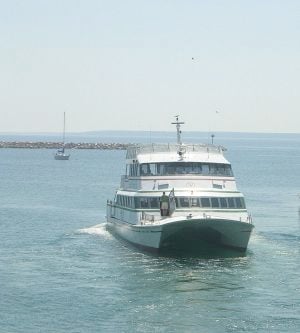
Mackinac Island is about eight miles (13 km) in circumference and 3.8 square miles (9.8 km²) in total area.[1] The highest point of the island is the historic Fort Holmes (originally called Fort George by the British before 1815), which is 320 feet (97 m) above the lake level and 890 feet (270 m) above sea level.[5] According to the 2000 census, the island has a year-round population of 523.[6] The population grows considerably during summer as hotels, restaurants, bars and retail shops, open only during the summer season, hire short-term employees to accommodate as many as 15,000 visitors per day.[7] [8]
The island can be reached by private boat, by ferry, by small aircraft, and in the winter, by snowmobile. The airport has a 3,500-foot (1,070 m) paved runway, and charter air service from the mainland is available.[9] In the summer tourist season, three separate ferry services shuttle visitors to the island from St. Ignace and Mackinaw City.[10]
Motorized vehicles have been prohibited on the island since 1898, with the exception of snowmobiles during winter, emergency vehicles, and service vehicles. Travel on the island is either by foot, bicycle, or horse-drawn carriage. Bicycles, carriages, and saddle horses are available for rent. An 8-mile (13 km) road follows the island's perimeter, and numerous roads, trails and paths cover the interior.[11] The road encircling the island and closely hugging the shoreline is M-185, the United States' only state highway without motorized vehicles.[12]
The island is the location of Mackinac Island State Park, which covers about 80 percent of the island and includes Fort Mackinac and portions of the island's historic downtown and harbor. [10]
Geology
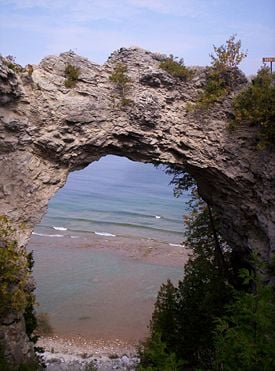
Mackinac Island was formed as the glaciers of the last ice age began to melt around 13,000 B.C.E. The bedrock strata that underlie the island are much older, dating to Late Silurian and Early Devonian time, about 400 to 420 million years ago. Subsurface deposits of halite (rock salt) dissolved, allowing the collapse of overlying limestones; these once-broken but now solidified rocks comprise the Mackinac Breccia.
The melting glaciers formed the Great Lakes, and the receding lakewaters eroded the limestone bedrock, forming the island's steep cliffs and rock formations. At least three previous lake levels are known, two of them higher than the present shore: Algonquin lakeshores date to about 10,000 years ago, and the Nipissing shorelines formed about 12,000 years ago.[13] During an intermediate period of low water between these two high-water stages, the Straits of Mackinac shrank to a narrow gorge which discharged its water into Lake Huron through Mackinac Falls, located just east of Mackinac Island.[14]
As the Great Lakes assumed their present levels, Mackinac Island took on its current size.[1] The steep cliffs were one of the primary reasons for the British army's choice of the island for a fortification; their decision differed from that of the French army, which had built Fort Michilimackinac about 1715 near present-day Mackinaw City. The limestone formations are still part of the island's appeal. However, tourists are attracted by the natural beauty rather than the strategic value. One of the most popular geologic formations is Arch Rock, a natural limestone arch, nearly 150 feet (45 m) above the ground.[15] Other popular geologic formations include Sugar Loaf and Skull Cave.
Ecology
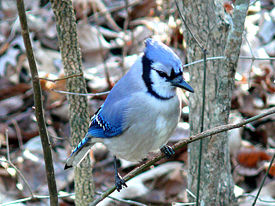
Mackinac Island contains a wide variety of terrain, including fields, marshes, bogs, coastline, boreal forest, and limestone formations. The environment is legally preserved on the island by the State Historic Park designation. About half of the shoreline and adjacent waters off Mackinac Island, including the harbor (Haldimand Bay) and the southern and western shore from Mission Point to Pointe aux Pins, is protected as part of the Straits of Mackinac Shipwreck Preserve, a state marine park.[16] As it is separated from the mainland by 3 miles (4.8 km) of water, few mammals inhabit the island, except those that traverse the ice during the winter months. Bats are the most abundant mammals as crossing the water is no obstacle for them. There are many limestone caves serving as homes for the bats and many insects on the island for the bat to prey on. The island is frequented by migratory birds on their trips between their summer and winter habitats. Eagles and hawks are abundant in April and May, while smaller birds such as Yellow Warblers, American Redstart, and Indigo Bunting are more common in early summer. Near the shoreline, gulls, herons, geese, and loons are common. Owls, including Snowy Owls and Great Grey Owls, come to the island from the Arctic to hunt in the warmer climate. Other birds, such as chickadees, cardinals, Blue Jays, and woodpeckers, live on the island year-round. Toads have also been found. [17]
Mackinac Island contains over 600 species of vascular plants. Flowering plants and wildflowers are abundant, including Trillium, Trout Lily, Spring Beauty, Hepatica, Buttercups, and Hawkweeds in the forests and Orchids, Fringed Gentian and Jack-in-the-Pulpit along the shoreline. The island's forests are home to many varieties of trees, such as maple, birch, elm, cedar, pine, and spruce.[17]
History

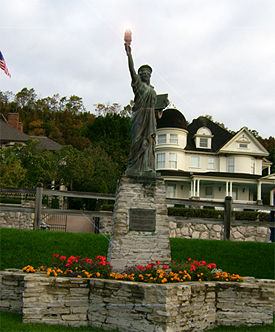
Archaeologists have excavated prehistoric fishing camps on Mackinac Island and in the surrounding areas. Fishhooks, pottery, and other artifacts establish a Native American presence at least 700 years before European exploration, around 900 C.E. The island is a sacred place in the tradition of some of its earliest known inhabitants, the Anishinaabe (Ojibwa) tribes, who consider it to be home to the Gitche Manitou, or the "Great Spirit".[18] According to legend, Mackinac Island was created by the Great Hare, Michabou and was the first land to appear after the recession of the Great Flood.[19] The island was a gathering place for the local tribes where their offerings were made to Gitche Manitou and was where tribal chiefs were buried.
The first European likely to have seen Mackinac Island is Jean Nicolet, a French-Canadian coureur de bois, during his 1634 explorations. The Jesuit priest Claude Dablon founded a mission for the Native Americans on Mackinac Island in 1670, and stayed over the winter of 1670-71. Dablon's fall 1671 successor, the missionary and explorer Jacques Marquette, moved the mission to St. Ignace soon after his arrival.[20][21] With the mission as a focus, the Straits of Mackinac quickly became an important French fur trading location. The British took control of the Straits of Mackinac after the French and Indian War and Major Patrick Sinclair chose the bluffs of the island for Fort Mackinac in 1780.[22][18]
Although the British built Fort Mackinac to protect their settlement from attack by Americans and native tribes, the fort was never attacked during the American Revolutionary War and the entire Straits area was officially acquired by the United States through the Treaty of Paris in 1783. However, many of the British forces did not leave the Great Lakes area until after Jay's Treaty established U.S. sovereignty over the entire Northwest Territory in 1794.[23] During the War of 1812, the British captured the fort in the first battle of the conflict because the Americans had not yet heard that war had been declared. The victorious British attempted to protect their prize by building Fort George on the high ground behind Fort Mackinac. In 1814, the Americans and British fought a second battle on the north side of the island. The American second-in-command, Major Andrew Hunter Holmes, was killed and the Americans failed to recapture the island.
Despite this outcome, the Treaty of Ghent forced the British to return the island and surrounding mainland to the U.S. in 1815. The United States reoccupied Fort Mackinac, and renamed Fort George Fort Holmes, after Major Holmes.[5] Fort Mackinac remained under the control of the United States government until 1895 and provided volunteers to defend the Union during the American Civil War. The fort even served as a prison for three Confederate sympathizers.[18]
John Jacob Astor's American Fur Company was centered on Mackinac Island after the War of 1812 and exported beaver pelts for 30 years. By the middle of the nineteenth century, commercial fishing for whitefish and lake trout began to replace the fur trade as the island's primary industry. As sport fishing became more popular in the 1880s, hotels and restaurants accommodated tourists coming by train or lake boat from Detroit and similar cities.
Following the Civil War, the island became a popular tourist destination for residents of cities on the Great Lakes. Much of the federal land on Mackinac Island was designated as Mackinac National Park in 1875, just three years after Yellowstone was designated as the first National Park. To accommodate an influx of tourists in the 1880s, the boat and railroad companies built hotels, including the Grand Hotel. Souvenir shops began to spring up as a way for island residents to profit from the tourists. Many wealthy industrialists built summer cottages along the island's bluffs for extended stays. When the federal government left the island in 1895, all of the federal land, including Fort Mackinac, was given to the state of Michigan and became Michigan's first state park. The Mackinac Island State Park Commission appointed to oversee the island has limited private development in the park and requires leaseholders to maintain the island's distinctive Victorian architecture.[24][25]
Motor vehicles were restricted at the end of the nineteenth century because of concerns for the health and safety of the island's residents and horses after local carriage drivers complained that automobiles startled their horses. This ban continues to the present with exceptions only for emergency and construction vehicles.[26][18]
Historic places
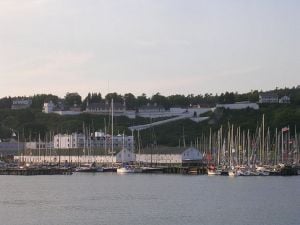
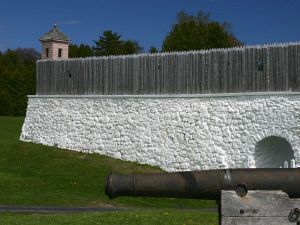
All of Mackinac Island was listed as a National Historic Landmark in October 1960. In addition, because of the island's long history and preservation efforts starting in the 1890s, eight separate locations on the island, and a ninth site on adjacent Round Island, are listed in the United States National Register of Historic Places.[18]
- Fort Mackinac was built in 1780 and was closed as a fort in 1895 as it no longer had any strategic purpose. It has been restored to its late nineteenth century state through efforts beginning in the 1930s.[27][28]
- The Matthew Geary House was built in 1846, was added to the register in 1971, and is now available for vacation rentals. [29]
- The Grand Hotel is a Victorian-style structure that opened in 1887. It gained national prominence after the 1980 film Somewhere in Time was shot on location at the hotel.[30]
- The Indian Dormitory was constructed after the signing of the 1836 Treaty of Washington as a place for Native Americans visiting the island to receive their yearly allotments and as a school. U.S. Indian Agent at that time was Henry R. Schoolcraft, who married a Native American woman and traveled widely to collect tales and folklore of the native residents. The building was restored in 1966 and converted to a museum.[31]
- Mission Church was built in 1829 and is the oldest surviving church building in Michigan. Restoration efforts have returned the church to its 1830s appearance.[32]
- Mission House was built in 1825 as a boarding school for Native American children. It became a hotel in 1849 and a rooming house in 1939. It is restored and now houses State Park employees.[33]
- The Round Island Lighthouse is located just south of the island on the small, uninhabited Round Island. The light was built in 1894 and automated in 1924. Extensive restoration efforts began in the 1970s and the exterior and structure have since been repaired.[34]
- The Agency House of the American Fur Company was built in 1820 as the home for the company's Mackinac Island agent, Robert Stuart. It is now open to the public as a fur trade museum.[35]
- The Michigan Governor's Summer Residence was built overlooking the harbor in 1902 and was purchased by the state for use as a governor's residence in 1943.[36]
- The entire island, Haldimand Bay, and a small shipwreck form a historic district.[37]
Culture
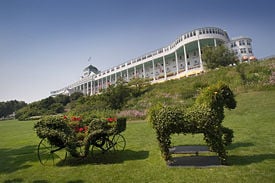
Mackinac Island is home to many cultural events, including an annual show of American art from the Masco collection of nineteenth century works at the Grand Hotel. There are at least five art galleries on the island.[38] Mackinac Island has been the setting of two feature films: This Time for Keeps in 1946 and Somewhere in Time, filmed at the Grand Hotel and various other locations on the island in 1979.[39] Mackinac Island has been written about and visited by many influential writers including Alexis De Tocqueville, Margaret Fuller, Henry David Thoreau, Edward Everett Hale, Mark Twain, and Constance Fenimore Woolson.
Favorable growing conditions have allowed lilacs to thrive on the island. Since 1949, the island's residents have been celebrating the lilacs with an annual 10-day festival, culminating in a horse-drawn parade that has been recognized as a local legacy event by the Library of Congress.
Most of the buildings on Mackinac Island are built of wood, a few are of stone, and most have clapboard siding.[1] The architectural styles on the island span 300 years, from the earliest Native American structures to the English styles of the nineteenth century. The earliest structures were built by the Anishinaabe and Ojibwe (Chippewa) tribes before European exploration. At least two buildings still exist from the original French settlement in the late eighteenth century, making Mackinac Island the only example of northern French rustic architecture in the United States, and one of few survivors in North America. Fort Mackinac, with its whitewashed stone walls instead of the more traditional wood, is a European adaptation of Islamic military architecture. Mackinac Island also contains examples of Federalist, Colonial, and Greek revival styles. Much of the island, however, is built in the style of the Victorian era which includes Gothic Revival, Stick style, Italianate, Second Empire, Richardson Romanesque and Queen Anne styles. The most recent styles used on the island date from the late 1800s to the 1930s and include the Colonial and Tudor revival styles.[40]
Notes
- ↑ 1.0 1.1 1.2 1.3 National Historic Landmark Nomination - Mackinac Island United States Department of the Interior Retrieved November 8, 2007. Cite error: Invalid
<ref>tag; name "HistplacesPDF" defined multiple times with different content - ↑ John D. Nichols, and Earl Nyholm, (1995). A Concise Dictionary of Minnesota Ojibwe. (Minneapolis: University of Minnesota Press)
- ↑ Douglas Harper. "Mackinaw" Online Etymology Dictionary [1] accessdate 2007-03-08
- ↑ Kelly Ferjutz. "Broadcloth, Brocade and Buckskin—Return to the past on Mackinac Island." FrugalFun.com [2]. accessdate 2007-03-08
- ↑ 5.0 5.1 Fort Holmes Brennan, James The Michigan Historical Marker Web Site Retrieved November 15, 2007.
- ↑ Mackinac Island, Michigan city-data.com Retrieved November 8, 2007.
- ↑ [3] Eselco Inc Retrieved November 8, 2007.
- ↑ Welcome to Mackinac Island Superior Sights Retrieved November 8, 2007.
- ↑ By Air Mackinac.com Retrieved November 8, 2007.
- ↑ 10.0 10.1 Mackinac Island FAQs Mackinac State Historic Parks Retrieved November 8, 2007.
- ↑ Brian Dearle,Mackinac Island The New Colonist. Retrieved November 8, 2007.
- ↑ Exhibits Mackinac Island State Parks.
- ↑ "Geology and Glacial Lake Shoreline Features of Mackinac Island." American Institute of Professional Geologists. [4]. accessdate 2007-05-18
- ↑ Ancient Waterfall Discovered Off Mackinac Island's Shoreline. Mackinac Island Town Crier [5] accessdate 2007-09-10
- ↑ Arch Rock on Mackinac Island, MI Vacations Made Easy Retrieved November 15, 2007.
- ↑ Dan Holden Bailey. Mackinac Straits. Diver Magazine September 1999, [6] accessdate 2007-05-23
- ↑ 17.0 17.1 Mary McGuire Slevin. Ecosystem. MackinacIsland.org. [7] accessdate 2007-05-17
- ↑ 18.0 18.1 18.2 18.3 18.4 Slevin. History MackinacIsland.org. [8] accessdate 2007-03-08
- ↑ Pat Zacharias. "The breathtaking Mackinac Bridge" Detroit News [9] accessdate 2007-07-18
- ↑ Raphael N. Hamilton, S.J. Father Marquette. (Grand Rapids: William B. Eerdmans), 43
- ↑ James Boynton, S.J. Fishers of Men: The Jesuit Mission at Mackinac, 1670-1765. (Mackinac Island: Ste. Anne's Church, 1996), 14-15
- ↑ Eugene T. Petersen. High Cliffs. Mackinac.com. [10]. accessdate 2007-03-04 }}
- ↑ Alan Brinkley. American History: A Survey, 11th ed. 2003. (New York: McGraw-Hill Higher Education, ISBN 0072424362), 141, 173
- ↑ Eugene T. Petersen. "A Historic Treasure Preserved." Mackinac.com [11]. accessdate 2007-03-05
- ↑ Petersen. "The Victorian Era: A Resort Meca." [12]. Mackinac.com. accessdate 2007-03-05
- ↑ Mary McGuire Slevin. "Mackinac Island Fact Sheet" Mackinac Island Tourism Bureau. [13]. accessdate 2007-03-05
- ↑ "Fort Mackinac" Hunt's Guide to Michigan's Upper Peninsula.' Midwestern Guides. [14]. accessdate 2007-05-23
- ↑ "A Brief History of Fort Mackinac" Mackinac Island State Park Commission. [15] accessdate 2007-05-23
- ↑ Geary House Rental. Mackinac Island State Park Commission [16]. accessdate 2007-05-23
- ↑ Grand Hotel. Roadside America [17]. accessdate 2007-09-10
- ↑ Eugene Petersen. "Indian Dormitory." History of Mackinac Island Mackinac.com [18] accessdate 2007-05-23
- ↑ "Your Wedding at Mission Church." Mackinac Island State Park Commission [19] accessdate 2007-05-23
- ↑ "Mission House" MI State Historic Preservation Objects. [20]. accessdate 2007-05-23
- ↑ Terry Pepper. "Round Island Light." 2003-12-12 [21], accessdate 2007-05-23
- ↑ Market Street, 1820s fur trade center. Hunts' Guide to Michigan's Upper Peninsula. Midwestern Guides. [22]. accessdate 2007-05-23
- ↑ Governor's Summer Residence Tours. Mackinac Island State Park Commission. [23]. accessdate 2007-05-23
- ↑ "MICHIGAN - Mackinac County" Nationalregisterofhistoricalplaces.com. [24]. accessdate 2007-03-09
- ↑ Mary McGuire Slevin. The Arts Mackinacisland.org. Retrieved November 15, 2007.
- ↑ Titles with locations including Mackinac Island IMDB. Retrieved November 15, 2007.
- ↑ Mary McGuire Slevin. Architecture Mackinacisland.org. Retrieved November 15, 2007.
References
ISBN links support NWE through referral fees
- Cantor, George. Explore Michigan-Mackinac. (Insider's Guide to Michigan) University of Michigan Press, 2005. ISBN 0472031112
- Havighurst, Walter. 1966. Three flags at the straits; the forts of Mackinac. American forts series. Englewood Cliffs, NJ: Prentice-Hall.
- Kachadurian, Thomas. 2000. Views of Mackinac Island. Chelsea, Mich: Sleeping Bear Press. ISBN 1585360066
- Phipps, Terry W. Seasons of Mackinac (Michigan Photographic) University of Michigan Press, 2004. ISBN 0472114441
- Schoolcraft, Henry R. (1839). Algic Researches. Mineola, NY: Dover reprint. 1998. ISBN 0486401871 (compilation of legends collected from American tribes)
- United States. 1968. Founders and frontiersmen; historic places commemorating early nationhood and the westward movement, 1783-1828. National survey of historic sites and buildings, v. 7. Washington: [For sale by the Supt. of Docs., U.S. Govt. Print. Off.].
External links
All links retrieved November 5, 2022.
- M-185 Route Listing at Michigan Highways
Credits
New World Encyclopedia writers and editors rewrote and completed the Wikipedia article in accordance with New World Encyclopedia standards. This article abides by terms of the Creative Commons CC-by-sa 3.0 License (CC-by-sa), which may be used and disseminated with proper attribution. Credit is due under the terms of this license that can reference both the New World Encyclopedia contributors and the selfless volunteer contributors of the Wikimedia Foundation. To cite this article click here for a list of acceptable citing formats.The history of earlier contributions by wikipedians is accessible to researchers here:
- Mackinac Island history
The history of this article since it was imported to New World Encyclopedia:
- History of "Mackinac Island"
Note: Some restrictions may apply to use of individual images which are separately licensed.
↧ Download as ZWI file | Last modified: 02/04/2023 00:16:30 | 15 views
☰ Source: https://www.newworldencyclopedia.org/entry/Mackinac_Island | License: CC BY-SA 3.0
 ZWI signed:
ZWI signed: KSF
KSF